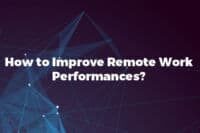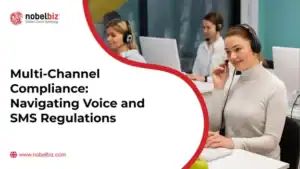Remote working became prevalent during the Coronavirus outbreak. This particular kind of work environment has enabled many businesses and contact centers to retain service continuity. However, it is not a walk in the park to integrate remote work in contact centers. So, how can you arrange remote working while maintaining your agent’s performance? What does this entail in terms of practice, technology, and organizational structure? What steps should you take to ensure that teleworking does not have a detrimental influence on the efficiency, quality, and performance of your Contact Center?
The goal of this article is to provide contact centers owners and managers with all of the necessary information to properly utilize remork work and to empower contact center agents.
The Oddity of Remote Work Environment
What’s particularly odd with the Remote Work Environment is that most contact centers who happily embraced the virtual call center model noticed that it had no effect on agent productivity over the first several months. However, as time went by, long-term consequences have started to arise in this new reality of work challenges that it brings in terms of:
- Management: Contact center supervisors and manager must properly stay in touch with remote agents and keep them engaged while appropriately monitoring productivity and customer and staff happiness,
- Knowledge: Agents require the proper tools and knowledge in order to give the best service possible. Agents that are motivated, well-equipped, trained, and knowledgeable have a favorable influence on productivity and customer satisfaction.
- Engagement: In interviews, contact center agents expressed a desire to communicate with their coworkers and stay connected to their team and organization.
Challenges & Difficulties for agents
This is the first question you must answer for yourself. If you wish to implement remote work in your Contact Center, your agents must have a teleworking-friendly home. Do they have a proper desk, a chair, and access to the internet at home? Similarly, it is not stated that they have at their disposal an isolated chamber to operate in quietness. Working from home may be a nightmare if you share a tiny flat with numerous other people and particularly if there are children. You should interview your consultants to answer this question and analyze their situation.
Here are some suggestions:
- If your agents do not have access to the internet, one option is to cover the expense of the membership.
- You might do the following for counselors who work with children:
- Offer them a change in their work schedule or more flexible hours.
- To avoid children from inadvertently disturbing phone conversations, instruct them to exclusively offer communication email, chat, or text messaging.
- Give them noise-cancelling headphones.
The majority of contact center workers operate from a computer, which is outfitted with a keyboard, a mouse, and one or more displays. This equipment is difficult to carry. Some contact centers have switched from desktop computers to laptop computers to allow telecommuting. This is a costly option, but laptops make switching from working at home to working in the office and back again considerably simpler. This is an option to explore if you want to use remote work substantially in the future.
Adequate Software Solutions
Agents must have access to all of the tools and software they require to complete their tasks, as they may be tempted to use their own computers to access some of the tools through a web browser. However, this might raise concerns about security and dependability (personal computers may not be powerful or secure enough to use these tools).
Notes and suggestions:
- Make a list of all the equipment that agents require for their jobs. The aim is for no agents to say, “I can’t do it because I’m not in the office.” All of the instruments required must be available from the advisers’ residences.
- The platform for sharing internal papers must be safe.
- Rather than traditional software that must be installed, go for cloud-based software that is available in SaaS mode. Most Contact Center Management, ticketing, and flow routing systems are now accessible in the cloud, and some are only available there.
Collaboration must continue
 Contact Center agents are frequently needed to collaborate in order to address client requests. Interactions with coworkers or a supervisor, transfer of a call to a manager…When all of the collaborators are in the same area, it is easier to communicate ideas: agents simply raise their hand or take some steps. However, mutual assistance amongst colleagues becomes more difficult when they are separated… which can result in a lengthier processing time for client requests or possibly a deterioration in the quality of the responses supplied. So, what should be done?
Contact Center agents are frequently needed to collaborate in order to address client requests. Interactions with coworkers or a supervisor, transfer of a call to a manager…When all of the collaborators are in the same area, it is easier to communicate ideas: agents simply raise their hand or take some steps. However, mutual assistance amongst colleagues becomes more difficult when they are separated… which can result in a lengthier processing time for client requests or possibly a deterioration in the quality of the responses supplied. So, what should be done?
Here are some suggestions:
- Set up a collaborative feature within your contact center solution and teach your agents how to use it. We’re talking about technologies that allow an agent to communicate with linked peers in real time. This includes individual exchanges and discussion groups.
- Select a solution that can communicate and be integrated with your call management software and CRM.
- Enhance your Knowledge Base with a chapter devoted to remote work and best practices, which includes all of the methods, rules, and solutions to particular telecommuting queries.
Remote Management for Supervisors
Remote work environments have an influence not just on how agents work, but also on how supervisors operate.
The supervisor’s responsibility is to guarantee that the agents perform an excellent and qualitative job. It is simpler to control the quality of work when the supervisor is in the same room as his team as he is able to see and hear each agent. However, in the remote work environment it becomes more difficult to oversee their performance. The tools can compensate for the lack of direct touch in this scenario. We recommend that you set up a dashboard to remotely assess the performance of your agents.
Let’s have a look at the three most important characteristics of a good remote agent:
- Schedules must be followed: It may be calculated using the Contact Center software. A telephony solution, for example, provides a supervisor interface via which the supervisor may regulate the total communication time per agent, the break time, the number of calls taken and missed, and so on.
- Productivity: It begins by setting your productivity goals, such as the amount of time spent on the phone with customers or the number of cases resolved. You may then use the program to determine whether or not the agents have attained certain productivity levels. Set reasonable and fairly feasible productivity goals, bearing in mind that advisors’ productivity might suffer when they don’t have a proper work environment at home.
- Quality: If you haven’t already, we recommend that you utilize a satisfaction indicator to assess the quality of your consultants’ work. Consider the Net Promoter Score. This will allow you to track client satisfaction with your Contact Center and thus indirectly the quality of the work of your agents.
How to improve performance in a remote work environment?
 To begin, it is critical to confirm the actual virtual presence of your team members. This indicator is quite handy for keeping track of the status of your teams. For example, if one of your workers often connects late to work in the morning, disconnects early, or takes an unusual amount of sick days, it is probable that he or she has lost motivation and is not performing to his or her full capacity.
To begin, it is critical to confirm the actual virtual presence of your team members. This indicator is quite handy for keeping track of the status of your teams. For example, if one of your workers often connects late to work in the morning, disconnects early, or takes an unusual amount of sick days, it is probable that he or she has lost motivation and is not performing to his or her full capacity.
Employee absenteeism can be caused by a variety of causes, including a lack of motivation, health issues, burnout, and so on. Unfortunately, this absence has ramifications for the remainder of the team, which may be subjected to increased stress or effort. Eventually, your work teams may be significantly disrupted, and the employees that are there may also be absent. So it is necessary to monitor and watch this indicator while implementing a positive culture within your contact center.
Knowledge base
An effective knowledge management platform provides remote agents with rapid access to client replies. Industry leaders are incorporating voice analytics and artificial intelligence (AI) into products that identify the customer’s query or intent. Passing this information to the AI-managed knowledge base finds the correct response to the customer’s query and lets the agent go to the next.
Online training and coaching
Companies want digital alternatives since group training and personal coaching are not viable options. Contact Centers may give specialized online training and coaching to agents based on performance statistics by utilizing data from automated quality management, speech analytics, and gamification.
Monitoring Quality
In the age of remote working, recording calls and screen interactions for coaching and compliance is even more crucial. Contact Centers can automate most of the labor associated with compliance monitoring and interaction scoring by integrating AI and automated language processing for speech and text analysis. This frees up more time for trainers and agents to focus on enhancing the client experience.
Unified Dashboards for Performances
Call center managers, supervisors, and agents are already using real-time and intraday KPI dashboards to help them make the best decisions. Contact centers can now provide remote agents with access to performance dashboards that include information based on omnichannel queues and team data, in addition to their individual performance. You may also add gamification features to these dashboards to further engage and encourage employees in real time.
Remote Management
Work-life balance is critical, especially for individuals who work from home. Keeping staff productive, engaged, and healthy necessitates careful planning. Sharing and suggesting timetables, as well as making modifications depending on agent preferences, are examples of best practices.
Cloud Contact Center Solutions Makes Remote Work Easy
 Cloud SaaS (software as a service) technologies have already transformed how businesses interact with their employees, exchange information, handle logistics, and coordinate their operations, among other things.
Cloud SaaS (software as a service) technologies have already transformed how businesses interact with their employees, exchange information, handle logistics, and coordinate their operations, among other things.
Contact center solutions such as NobelBiz Omni+ offer the same approach by connecting offices and agents from all around the world together on a single system. Day-to-day operations are considerably easier to handle, allowing you to concentrate on the service you provide and remain responsive in any circumstance.
Agents and supervisors may effortlessly interact with each other remotely using team messaging software, allowing them to function as effectively as they do in the office.
Furthermore, these tools allow you to form teams based on geography or area of expertise. Telecommuting staff can then contact the appropriate team and request assistance from inside specialists. Communication is simpler, agents keep in touch with different departments, and they feel more integrated into a team, all while providing superior customer service.
Conclusion: Finding the right balance between Monitoring and Understanding
Don’t rely only on data to judge your teams’ success; instead, spend time observing how your agent works to determine their efficacy. Keep in mind that your staff are not a straight line, but rather individuals who have good and bad days. Certain traits, like interpersonal skills and empathy for your clients and business partners, are worth their weight in gold and should not be overlooked when evaluating their overall performance.
Remember that assessing your agents’ performance isn’t only for evaluating their development. A shift in your team’s performance may also indicate something more significant in your organization, such as market shifts, a lack of buy-in for your product line, a marketing plan that needs to be reassessed, or corporate values that need to be better conveyed.
Finally, be explicit about your criteria for evaluating your talent’s performance and share this information with your team. Consider creating a clear and strategic dashboard that brings together your organization’s important numerical indicators. You will be able to better detect potential organizational problems, make educated decisions, and objectively measure the performance of your teams in this manner. This management tool will be beneficial not only to your management team, but also to your staff, who will be able to follow the progress of your goals.

Abdelmounim Benharouga has always had a strong passion for writing and digital marketing. He started as a Digital Content Writer part of marketing department then moved to being Customer Success Manager for the African Region within the Nobelbiz team.






